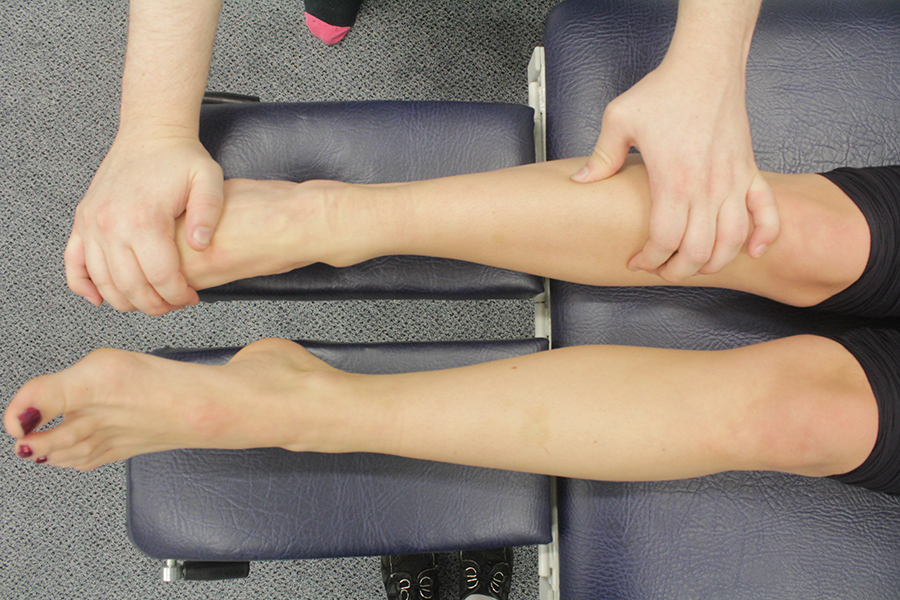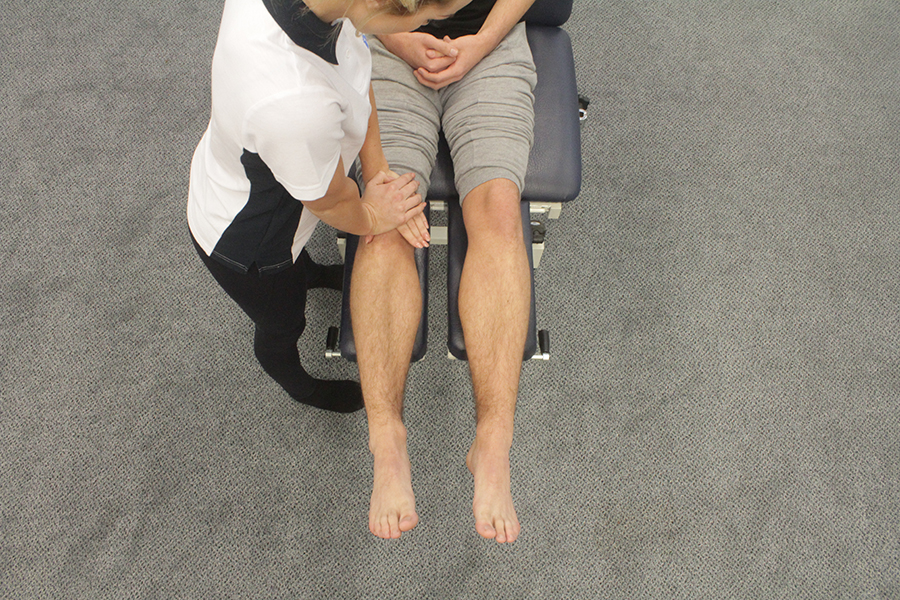Anterior compartment syndrome
Anterior compartment syndrome is a serious and painful condition that affects one of the muscles at the front of the leg. Anterior compartment syndrome occurs when the blood supply to the muscle is restricted due to a build-up of pressure inside the muscle compartment. The result is pain at the front of the leg, near the shin.
If you think you have anterior compartment syndrome you must visit a health professional immediately so that long term damage to the muscle and the leg is prevented.
Anterior compartment syndrome describes a serious and painful condition of the leg. Anterior compartment syndrome occurs when the pressure within the anterior compartment builds to a dangerous level.
The lower leg is divided into four separate compartments. These four compartments in the lower leg each contain muscles that are separated by a wall of tissue called fascia. Fascia is a flat band of fibrous tissue that separates and surrounds muscle. There are four compartments in the leg, and each one has its own blood and nerve supply.
The four compartments of the lower leg include: The anterior compartment is at the front of the leg and contains a large muscle called tibialis anterior. The tibialis anterior is an important muscle as it both extends and inverts the foot and ankle. The tibialis anterior muscle is surrounded by its own sheath of fascia; this is known as the anterior compartment.
The anterior compartment is at the front of the leg and contains a large muscle called tibialis anterior. The tibialis anterior is an important muscle as it both extends and inverts the foot and ankle. The tibialis anterior muscle is surrounded by its own sheath of fascia; this is known as the anterior compartment.
When pressure builds-up inside the anterior compartment the blood vessels and nerves that supply the muscle are compressed, this means that the blood flow is restricted. Once the blood flow to a muscle is restricted its oxygen supply is cut off. When the muscle does not receive oxygen it will stop working, and the muscle will die.
Anterior compartment syndrome is caused by:
Injury (acute):
When injured the pressure in the compartment can increase due to bleeding and swelling inside the compartment.
Exercise (chronic):
Exercise increases the blood flow to muscle. The extra blood flow is necessary for energy, which the muscle needs in order to function. Muscles get their energy from glucose (sugar), which is transported in the blood. Oxygen is then required to break down the glucose, therefore, the more glucose (energy) that is required by the muscle, the more oxygen that is needed to break it down.
In both acute and chronic anterior compartment syndrome the pressure within the compartment builds because there is not enough room inside the compartment to accommodate the extra volume caused by the increase in blood flow. The reason that there is not enough room is because the band of facia that forms the compartment is tightly wrapped around the muscle.
When the pressure inside the compartment builds to a certain level the blood vessels (which supply the muscle with the much needed oxygen rich blood) are cut off. Muscles need oxygen in order to work efficiently; therefore, if the blood supply is cut off the muscle will die.
The nerves that supply the muscle can also be affected leading to numbness and/or weakness in the leg.
In the most serious cases amputation is necessary, particularly when infection is also present.
The signs and symptoms of chronic anterior compartment syndrome are not present all of the time; instead they appear during and immediately after activity. The signs and symptoms of chronic anterior compartment syndrome include:

There are two types of anterior compartment syndrome, they are:
Chronic compartment syndrome is also known as excertional compartment syndrome. Chronic compartment syndrome is typically observed in athletes and is described as an overuse condition. Chronic compartment syndrome is characterised by pain in the muscle, which comes on with exercise and then gradually gets worse as the activity continues. The pain will increase until the person has to stop what they are doing; the pain will then go away with rest.
Acute compartment syndrome is an incredibly serious condition. It is a medical emergency that can be both leg and life threatening.
Unlike chronic compartment syndrome, acute compartment syndrome is NOT exercise induced and the pain is not relieved by rest.
Acute compartment syndrome is caused by trauma (e.g. a break, laceration, gunshot wound etc.).
A podiatrist here at Chiropody.co.uk will be able to diagnose chronic anterior compartment syndrome. They will base their diagnosis on a thorough history and the signs and symptoms.
This section refers only to chronic anterior compartment syndrome only. This is because acute anterior compartment syndrome requires emergency medical attention and the patient must attend A & E.
If you think you may have chronic anterior compartment syndrome one of our podiatrists here at Chiropody.co.uk would first need to obtain a medical history and a history of the problem. The history, along with the signs and symptoms and an assessment of the leg will lead the podiatrist to a diagnosis. The podiatrist may want to replicate your symptoms to confirm their diagnosis, you may therefore be asked to walk or run on a treadmill.
Once a diagnosis of anterior compartment syndrome has been confirmed, the following treatment options may be discussed:
Anterior compartment syndrome is a serious and painful condition that affects a muscle at the front of the leg called tibialis anterior. The anterior compartment consists of the tibialis anterior muscle and a wall of fascia, which wraps around the muscle separating it from other muscles in the leg.
Anterior compartment syndrome occurs when the blood supply to the muscle is restricted due to a build-up of pressure inside the muscle compartment. The result is pain at the front of the leg, near the shin.
There are two types of anterior compartment syndrome; chronic and acute. Chronic anterior compartment syndrome is caused by exercise. If you have exercise induced (chronic) anterior compartment syndrome there is an increase in pressure inside the muscle compartment due to an increase in volume that is the result of increased blood flow. Acute anterior compartment syndrome occurs as a result of traumatic injury and is a medical emergency.
To arrange an assessment with one our podiatrists please email office@chiropody.co.uk or call 0330 088 4222.
If you think you have anterior compartment syndrome you must visit a health professional immediately so that long term damage to the muscle and the leg is prevented.
What is anterior compartment syndrome?
Anterior compartment syndrome describes a serious and painful condition of the leg. Anterior compartment syndrome occurs when the pressure within the anterior compartment builds to a dangerous level.
The lower leg is divided into four separate compartments. These four compartments in the lower leg each contain muscles that are separated by a wall of tissue called fascia. Fascia is a flat band of fibrous tissue that separates and surrounds muscle. There are four compartments in the leg, and each one has its own blood and nerve supply.
The four compartments of the lower leg include:
- The anterior compartment
- The lateral compartment
- The superficial posterior compartment
- The deep posterior compartment
 The anterior compartment is at the front of the leg and contains a large muscle called tibialis anterior. The tibialis anterior is an important muscle as it both extends and inverts the foot and ankle. The tibialis anterior muscle is surrounded by its own sheath of fascia; this is known as the anterior compartment.
The anterior compartment is at the front of the leg and contains a large muscle called tibialis anterior. The tibialis anterior is an important muscle as it both extends and inverts the foot and ankle. The tibialis anterior muscle is surrounded by its own sheath of fascia; this is known as the anterior compartment.
When pressure builds-up inside the anterior compartment the blood vessels and nerves that supply the muscle are compressed, this means that the blood flow is restricted. Once the blood flow to a muscle is restricted its oxygen supply is cut off. When the muscle does not receive oxygen it will stop working, and the muscle will die.
What causes anterior compartment syndrome?
Anterior compartment syndrome is caused by:
Injury (acute):
When injured the pressure in the compartment can increase due to bleeding and swelling inside the compartment.
Exercise (chronic):
Exercise increases the blood flow to muscle. The extra blood flow is necessary for energy, which the muscle needs in order to function. Muscles get their energy from glucose (sugar), which is transported in the blood. Oxygen is then required to break down the glucose, therefore, the more glucose (energy) that is required by the muscle, the more oxygen that is needed to break it down.
In both acute and chronic anterior compartment syndrome the pressure within the compartment builds because there is not enough room inside the compartment to accommodate the extra volume caused by the increase in blood flow. The reason that there is not enough room is because the band of facia that forms the compartment is tightly wrapped around the muscle.
When the pressure inside the compartment builds to a certain level the blood vessels (which supply the muscle with the much needed oxygen rich blood) are cut off. Muscles need oxygen in order to work efficiently; therefore, if the blood supply is cut off the muscle will die.
The nerves that supply the muscle can also be affected leading to numbness and/or weakness in the leg.
In the most serious cases amputation is necessary, particularly when infection is also present.
What are the signs and symptoms of anterior compartment syndrome?
The signs and symptoms of chronic anterior compartment syndrome are not present all of the time; instead they appear during and immediately after activity. The signs and symptoms of chronic anterior compartment syndrome include:
- Pain in the muscle at the front of the leg that comes on with exercise and gradually gets worse. The pain is relieved by rest. The pain is described as:
- Cramping
- Aching
- Swelling
- Pins and needles sensation
- Numbness
- Weakness

Types of anterior compartment syndrome
There are two types of anterior compartment syndrome, they are:
Chronic compartment syndrome
Chronic compartment syndrome is also known as excertional compartment syndrome. Chronic compartment syndrome is typically observed in athletes and is described as an overuse condition. Chronic compartment syndrome is characterised by pain in the muscle, which comes on with exercise and then gradually gets worse as the activity continues. The pain will increase until the person has to stop what they are doing; the pain will then go away with rest.
Acute compartment syndrome:
Acute compartment syndrome is an incredibly serious condition. It is a medical emergency that can be both leg and life threatening.
Unlike chronic compartment syndrome, acute compartment syndrome is NOT exercise induced and the pain is not relieved by rest.
Acute compartment syndrome is caused by trauma (e.g. a break, laceration, gunshot wound etc.).
How is anterior compartment syndrome diagnosed?
A podiatrist here at Chiropody.co.uk will be able to diagnose chronic anterior compartment syndrome. They will base their diagnosis on a thorough history and the signs and symptoms.
What would podiatry for anterior compartment syndrome involve?
This section refers only to chronic anterior compartment syndrome only. This is because acute anterior compartment syndrome requires emergency medical attention and the patient must attend A & E.
If you think you may have chronic anterior compartment syndrome one of our podiatrists here at Chiropody.co.uk would first need to obtain a medical history and a history of the problem. The history, along with the signs and symptoms and an assessment of the leg will lead the podiatrist to a diagnosis. The podiatrist may want to replicate your symptoms to confirm their diagnosis, you may therefore be asked to walk or run on a treadmill.
Once a diagnosis of anterior compartment syndrome has been confirmed, the following treatment options may be discussed:
- Stretching Programmes
- Soft tissue treatment
- Massage
- Myofascial release
- Fasciotomy (a surgical procedure that releases the pressure)
- Modification of training regime
Summary
Anterior compartment syndrome is a serious and painful condition that affects a muscle at the front of the leg called tibialis anterior. The anterior compartment consists of the tibialis anterior muscle and a wall of fascia, which wraps around the muscle separating it from other muscles in the leg.
Anterior compartment syndrome occurs when the blood supply to the muscle is restricted due to a build-up of pressure inside the muscle compartment. The result is pain at the front of the leg, near the shin.
There are two types of anterior compartment syndrome; chronic and acute. Chronic anterior compartment syndrome is caused by exercise. If you have exercise induced (chronic) anterior compartment syndrome there is an increase in pressure inside the muscle compartment due to an increase in volume that is the result of increased blood flow. Acute anterior compartment syndrome occurs as a result of traumatic injury and is a medical emergency.
To arrange an assessment with one our podiatrists please email office@chiropody.co.uk or call 0330 088 4222.
Save 5% by booking an appointment online.

Find your nearest clinic
We have clinics located throughout the North West. We also provide a home visit service.
Find out more »

No waiting lists!
Tired of waiting for treatment? Be seen by a podiatrist today!
Find out more »

Not sure how we can help?
Speak to a podiatrist to find out how we can help. Call us on 0330 088 4222.
Find out more »
We work with:

Individuals

Organisations

Health professionals
Get in Touch!
0330 088 4222
If you would like to speak to one of our specialists then please complete this form.
We are open 7 days a week








